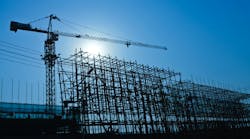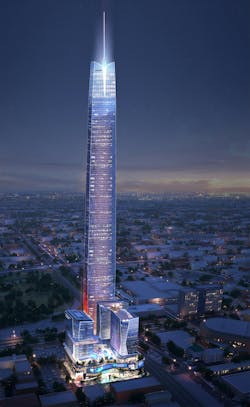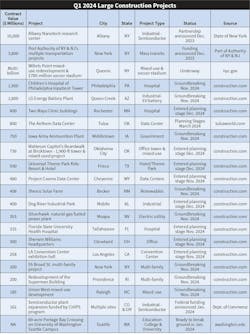Developers of projects in the rail/transportation, semiconductor chip, and electric vehicle (EV) construction verticals continue to enjoy federal funding from the Infrastructure Investment and Jobs Act (IIJA) and the Creating Helpful Incentives to Produce Semiconductors (CHIPS) Act.
While updating our construction project database, EC&M’s editors were surprised at the continuing surge of rail, semiconductor, and EV projects breaking ground or on the drawing boards (Table on page 10). The Albany Nanotech research center in upstate New York is expected to eventually attract $10 billion in investment in new manufacturing facilities, research and development labs, and training from a consortium of semiconductor manufacturers, including IBM, Micron, Applied Materials, and Tokyo Electron for construction of the first and only publicly owned High NA Extreme Ultraviolet Lithography Center in North America.
The Port Authority of New York and New Jersey also has big construction plans, with a $3.6-billion capital expense budget to fund several major projects, including the ongoing construction at John. F. Kennedy Airport; the replacement of the Port Authority Bus Terminal; and the development of a new AirTrain system at Newark Airport.
Oklahoma City may one day be home to the tallest tower in the United States if the Matteson Capitol’s plans for the Boardwalk at Bricktown go through (Photo). The developer wants to build a 1,907-ft apartment mixed-used tower. According to a post at www.freepressokc.com and an article in The Oklahoman, the 5-million-sq-ft development, currently estimated at more than $700 million in total contract value, would also include 1,776 residential units in a 134-story apartment tower as well as restaurants and other retail stores.
Other trophy jobs include the Willets Point redevelopment in Queens, N.Y., which will include several hundred units of affordable housing and a $780-million soccer stadium; the $1.9-billion Children’s Hospital inpatient tower in Philadelphia now underway; and the $1.6-billion LG Energy battery plant in Queen Creek, Ariz.
Additional projects of note include the $480-million Project Cosmo data center in Cheyenne, Wyo., now in the planning stage; the $406-million Sherco Solar Farm underway in Becker, N.M.; the $315-million Florida State University Health Hospital, Tallahassee, Fla., now being planned; and the Sherwin Williams headquarters in Cleveland on the drawing boards.
Overall, forecasters are looking for a steady, unspectacular year for the construction market. In AIA’s Consensus Construction Forecast, Kermit Baker the chief economist for the American Institute of Architects (AIA), wrote, “After increasing by more than 20% last year, spending on nonresidential buildings will see a much more modest 4% increase in 2024, at a pace that will slow to just over 1% growth in 2025. Spending on commercial facilities will be flat this year and next, manufacturing construction will increase almost 10% this year before stabilizing in 2025 and institutional construction will see mid-single-digit gains this year and next.”
Another good market indicator to watch is the Dodge Momentum Index (DMI) published monthly by the Dodge Construction Network. In December 2023, the DMI rose 3% to 186.6 points (2,000=100) from the revised November reading of 181.5 points, but it ended the year 11% below the November 2022 peak. The DMI is a monthly measure of the value of nonresidential building projects going into planning, shown to lead construction spending for nonresidential buildings by a full year. Sarah Martin, associate director of forecasting for Dodge Construction Network, said in a press release that ongoing labor and construction cost issues will persist in 2024 and that all of the projects on the drawing boards will support construction spending going into 2025.






